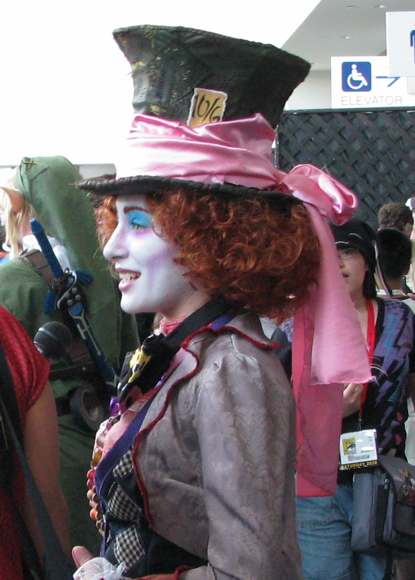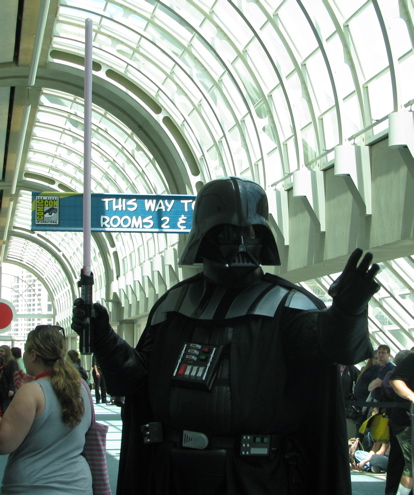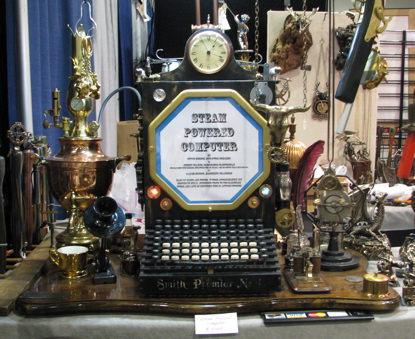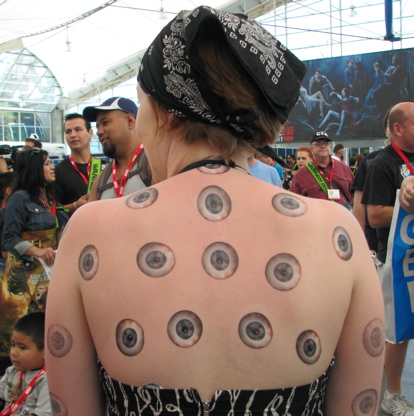new posts in all blogs
Viewing: Blog Posts Tagged with: SDCC 2010, Most Recent at Top [Help]
Results 1 - 8 of 8
How to use this Page
You are viewing the most recent posts tagged with the words: SDCC 2010 in the JacketFlap blog reader. What is a tag? Think of a tag as a keyword or category label. Tags can both help you find posts on JacketFlap.com as well as provide an easy way for you to "remember" and classify posts for later recall. Try adding a tag yourself by clicking "Add a tag" below a post's header. Scroll down through the list of Recent Posts in the left column and click on a post title that sounds interesting. You can view all posts from a specific blog by clicking the Blog name in the right column, or you can click a 'More Posts from this Blog' link in any individual post.
Again, these are books I haven’t read yet (except one)—I saw them at the con and they piqued my interest. The TBR pile moans.
Series by James Owen: The Chronicles of Imaginarium Geographica (I saw these last year too. Gorgeously designed fantasy series with an appealing premise, something about a map of all the imaginary worlds ever written about…
I Am Number Four by Pittacus Lore (they had a very cool one-of-a-kind handbound metal edition at the publisher’s table)
Hungry Tiger Press. This is the publisher of Eric Shanower’s beautifully illustrated new editions of L. Frank Baum’s Oz books. Eric won two Eisners this year for his edition of The Wonderful Wizard of Oz (a Marvel Comics project). Hungry Tiger publishes reprints of old Oz stories and other Baum work, including two books about The Flying Girl, “intrepid girl aviator Orissa Kane.” Baum was one of my favorite authors as a child—we still have my collection of Oz books—and I couldn’t resist bringing The Flying Girl home with me for a test flight.
Tigerbuttah by Becky and Frank of Tiny Kitten Teeth fame. My friend Sarah showed me a copy, and the art and title made me swoon. I hunted for the booth but this was late in the day on Sunday and we had a curry date with our pal Jock, so I gave up the search. The book was adorable—it’s made after the fashion of a Golden Book with many cunning details.
Buzzboy by John Gallagher. Had the pleasure of meeting John at the kidlit gathering and am looking forward to reading his comic about “what happens when the sidekicks take over.”
Nerds: National Espionage, Rescue, and Defense Society by Michael Buckley, illustrated by Ethan Beavers. Wonderful art & a fun premise—the nerds are kids who use technology to “upgrade” their weaknesses into superpowers. More about this (and all of the above) after I’ve had a chance to read.

By:
Melissa Wiley,
on 7/31/2010
Blog:
Here in the Bonny Glen
(
Login to Add to MyJacketFlap)
JacketFlap tags:
Books,
Christopher Paolini,
epic fantasy,
SDCC,
Megan Whalen Turner,
Brandon Sanderson,
high fantasy,
Patrick Rothfuss,
SDCC 2010,
Brent Weeks,
Lynn Flewelling,
Add a tag
It’s a week after Comic-Con and I’m still working through my notes! Two more panels and another booklist to post, and then it’s likely to get quiet around here for a spell.
I scrawled a crazy amount of notes at the Once Upon a Time panel—six authors of epic fantasy discussing their craft—but the odds of my being able to translate the scrawl to English are slimmish, so never fear. This was a fascinating panel. (Hence the 12 pages of notes.) Have I mentioned I love hearing other writers talk about their work? Yeah.
The panelists, in order of seating: Brandon Sanderson, Brent Weeks, Lynn Flewelling, Megan Whalen Turner, Christopher Paolini, Patrick Rothfuss. The moderator: Maryelizabeth Hart of the awesome Mysterious Galaxy bookstore. She was great. They were all great.
Hart’s first question was about the everyman character vs. the larger-than-life superheroic character. In epic fantasy, with these sweeping adventures and grand-scale worldbuilding, does the main character also need to be larger than life?
SANDERSON: talked about Bilbo and Frodo, everymen, little guys, ordinary, small. “If Tolkien did it, it must be okay.” (Gave context of Tolkien as originator of high fantasy.) Made interesting point about Sam having superheroic loyalty—i.e. Sam is not a typical everyman. But came back to “at core of every everyman there is something exceptional.”
WEEKS: If we can follow them [everyman characters] through that journey, we are great too. We know there is something great within us, potential; as the everyman becomes great, we become great with him.
FLEWELLING: likes to see the process (of becoming great), doesn’t like to see heroes from the start. Wants backstory. If protag is superstrong, etc, can be boring.
WHALEN TURNER: Likes themes of “extraordinary performances of ordinary people.” Talked in terms of flavors—her favorite flavor is a book about an extraordinary person, but it requires careful handling to maintain dramatic tension. Spoke about the Mary Sue character, two different definitions of that; one is “squicky,” where the character represents the author; but in another sense a Mary Sue character is an everyman who can represent the reader. She likes that, thinks it makes for satisfying story.
PAOLINI: Basically it comes down to: “Batman is better than Superman.” (Gets huge laugh.) Talked about the difference between the extraordinary SETTING and the extraordinary CHARACTER. You can put an extraordinary character in an ordinary setting (like Superman in Kansas corn field) or vice versa, ordinary guy in extraordinary setting (Frodo in Mordor). Over time, the ordinary character becomes larger-than-life—best example, he says, is Arthur Dent in Hitchhiker’s Guide to the Galaxy, “a larger-than-life doofus” with flaws and weaknesses.
ROTHFUSS: 1) Paolini beat him to the Batman thing. 2) He’s a contrarian so has to reflexively disagree with what everyone else said. (Big laugh.) For him, a really big story (and epic fantasy is always a really big story) needs an everyman for people to relate to. He also spoke about the Mary Sue—my notes say “Your main char is one”—was he talking to Paolini? I think so, think it got a laugh, Paolini nodding in agreement. Rothfuss likes characters like Cyrano, Odysseus—unusually cool and clever.
PAOLINI: discussed “hereditary vs earned skills” (again Superman—hereditary—and Batman—earned/learned). “Escalating powers” can make problems for a writer—if the guy can simply “snuff the sun,” no story left. He too likes CLEVERNESS in a character.
SANDERSON: talked about origin of epic fantasy, founded by Tolkien, before that there were heroic tales (Conan, Tarzan, the guy starts off as hero). Tolk
I didn’t take many notes on this one, but there are stories to tell. First of all, I went into it expecting a discussion about the show, the ending, our questions, our theories—I mean, I figured there would be five or six people up front debating and taking comments from the crowd. It wasn’t like that. What it actually was was an info session on DK’s soon-to-be-published LOST Encyclopedia, moderated by a DK rep, with the book’s two authors as panelists/interviewees.
This sounds very market-y, but it was FASCINATING. And before twenty minutes had passed, I had shifted from feeling very shruggy about the notion of an “encyclopedia” for a TV show, even one as intricate and awesome as LOST, to thinking I MUST HAVE THIS BOOK.
So: if it was a commercial, it was a darned effective one.
But it wasn’t really a commercial. It was two intelligent and enthusiastic writers talking about the process of researching, writing, and organizing a complex work of nonfiction. The visuals were interesting enough—sample layouts, even a short video clip from the LOST DVD’s bonus materials—but what really grabbed me was the authors’ discussion about how they worked with the LOST writers and producers to write entries on every single person, place, and thing that appeared on the show, from Aaron (Littleton) to Zodiac (raft). Or, as Paul Terry, one of the cowriters, kept adorably saying, “From A to Zed.”
My sparse notes say:
• Authors: Paul Terry and Tara Bennett. Liked these two very much. Clearly they are passionate about the material.
• The book will include everything that is LOST canon, including material from the not-yet-released bonus scene from the DVD, which of course I AM DYING TO SEE because I’m convinced it will be about—no wait, I can’t say, since my own dear daughter hasn’t made it past Season One yet. Must not spoil!! But, you know, if you’re a Lostie then you probably have a good guess as to what sort of story there might be left to tell…
• Book will offer clarifications, yes, but will not fill in the holes—that isn’t possible, said Bennett. No entries were winged; there are no speculations.
• Entries have levels of importance. A-level is major players, Jack, Locke, etc. D- or E-level would be something like Shannon’s asthma inhaler.
• One particular challenge was that the language had to be concrete, couldn’t leave opening for misinterpretation; the book was much harder to write than Terry and Bennett realized it would be when they took on the project.
• Once they were committed to writing it (seems to have happened perhaps midway through the run?), they stopped reading recap & speculation blogs, boards, etc; needed to keep their relationship to the show pure/uninfluenced by non-canonical theories & interpretations.
So much for my notes. But I said there were stories. The first one is actually from the panel before the LOST one, a discussion about webcomics by several successful creators. I went to this one out of mild interest, intending to stick around for the LOST panel since it was in the same room. The webcomics panel was structured as a “lightning round” Q-and-A: the panelists had 20 seconds each to answer questions from the audience. I’ll write up that panel when I get a chance; it was lively and interesting and funny. But the really funny part was when one of the questioners remarked, somewhat snidely, that unlike many people in the room, he was there for the webcomics panel specifically, not just camping out for a seat at LOST. The webcomics guys said, Wait, what? There’s a LOST panel in here next? And they asked for a show of hands: who was just waiting for LOST? About a third of the people in the audience raised their hands.
Ho-ho, said one of the webcomics guys. And for the next
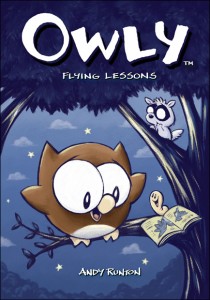 Again, quickly typing up my notes. These are things that piqued my interest and beg a closer look, when time permits.
Again, quickly typing up my notes. These are things that piqued my interest and beg a closer look, when time permits.
No particular order here except the order in which I encountered them at the con. (UPDATE: this post got too long! So now it’s a Part One.)
• Owly (kids’ graphic novels, the one I saw was wordless and sweet, published by Top Shelf Press)
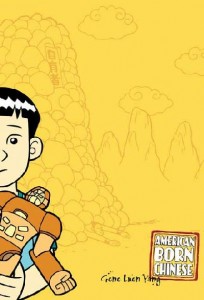 • Practically everything at the First Second (:01) booth made me drool—I was already familiar with these folks, having read (and been blown away by) Gene Luen Yang’s American Born Chinese a little while ago. Gene was on one of the children’s graphic novel panels I attended at SDCC last year.
• Practically everything at the First Second (:01) booth made me drool—I was already familiar with these folks, having read (and been blown away by) Gene Luen Yang’s American Born Chinese a little while ago. Gene was on one of the children’s graphic novel panels I attended at SDCC last year.
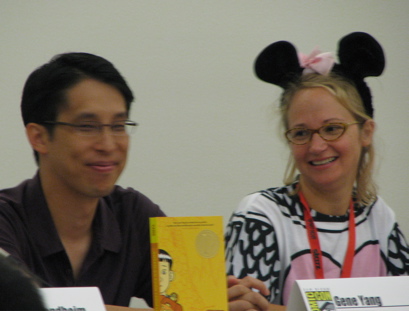 Gene Luen Yang and Jennifer Holm at SDCC 2009.
Gene Luen Yang and Jennifer Holm at SDCC 2009.
This year, “Urgent Request” from The Eternal Smile (written by Gene; illustrated by Derek Kirk Kim) won the Eisner for best short story, which is very exciting. To my amusement, at the very moment I was paging through Eternal Smile, I looked up and there was Gene with his family at the First Second booth. He and his wife had their three small children in tow—Gene was wearing the baby in a front-carrier, a heartwarming sight. We chatted briefly; it was a delight to meet them.
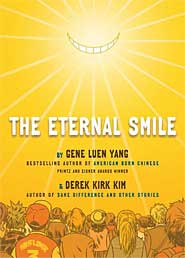
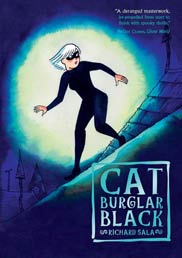
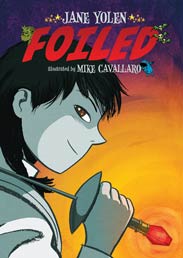
• Back to First Second Books. Other titles that caught my eye:
—Cat Burglar Black
—Adventures in Cartooning—we’ve checked this out from the library, big hit with my kids, but I don’t think I’ve mentioned it here before
—Foiled (Jane Yolen)—has been on my TBR list, even more appealing in person, wonderful art
—Tiny Tyrant
—The Color of Water
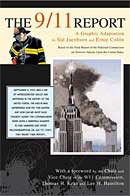
“So what do you do at Comic-Con, anyway?” a friend asked me. My con experience is generally quite different from most of my friends’ experiences there, the daytime parts at least. Most of my con pals are writers, artists, and editors who are there to work. They put in time at publishers’ booths, they sign books and do sketches, they speak on panels and meet fans and go to special events. For most pros, it’s a fun week, but a hard one too, often quite exhausting. People are usually pretty wiped out by Sunday afternoon. Even I am exhausted, and I didn’t have to work. As you know, I took a break from fiction writing with the last two babies, so I haven’t had any new books to promote in the past couple of years. (Though I suppose this is as good a time as any to tell you that I did get back to work in January, and I’ve finished a middle-grade novel and a young graphic novel, and they are both in the capable hands of my agent now, so yay for that! I’m feeling my way into the next book now. But that’s a topic for another post…)
 At dinner with Babymouse author and utterly lovable person, Jenni Holm, and her delightful husband, video game developer Jonathan Hamel. My crazy gremlin smile is because that is how happy they make me.
At dinner with Babymouse author and utterly lovable person, Jenni Holm, and her delightful husband, video game developer Jonathan Hamel. My crazy gremlin smile is because that is how happy they make me.
Anyway, for me, as a pro who has been on hiatus, SDCC is kind of an ideal convention experience: I get all the fun of spending time with writer and artist friends, many of whom I only see once a year, and I get to explore the vendor hall and scout out interesting new books to read—which you know is pretty much my favorite pastime—but I am also free to attend panels all day long, if I wish. And I love the panels at Comic-Con. I love listening to other creative professionals talk about their work. The folks who speak on SDCC panels are some of the smartest, most talented, most interesting people I’ve ever had the pleasure to listen to. Comic book writers and artists, children’s book writers, science fiction and fantasy authors, cartoonists, editors…a feast for the curious mind.
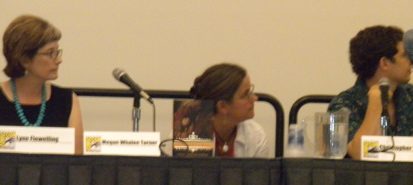
So: I went to lots of panels, and when I wasn’t tweeting about them, I took copious notes in my notebook—notes I will shortly attempt to write up here, for my own records if nothing else. Here are the panels I attended; I’d love to know which ones you’d be most interested in hearing more about:
• “Once Upon a Time”—panel on high fantasy with authors Brandon Sanderson, Brent Weeks, Lynn Flewelling, Megan Whalen Turner, Christopher Paolini, and Patrick Rothfuss. SUCH A GREAT DISCUSSION! Topics: everyman vs. superhero; role of prophecy/destiny in fiction.
• Digital comics (this one turned about to be more about marketing than the creative and technical processes)
• Webcomics
• The LOST Encyclopedia
• Rick Riordan interviewed by novelist Michael Scott (EXCELLENT panel; I tweeted notes and took many more)
• “Entertaining One’s Inner Child”—panel of children’s graphic novel author/illustrators moderated by Jennifer Holm. The panelists were: Jimmy Gownley (Amelia Rules), Sina Grace (Among the Ghosts), Matt Holm (Babymouse), Adam Rex (Fat Vampire), David Steinberg (Daniel Boom), and Greg Van Eekhout (Kid Vs. Squid).
• Spotlight on the legendary comic-book writer and Batman editor Dennis O&rs
The amazing, Eisner-nominated artist Fiona Staples drew this sketch for me. I can’t stop looking at it and giggling from sheer glee. Thanks, Fiona.
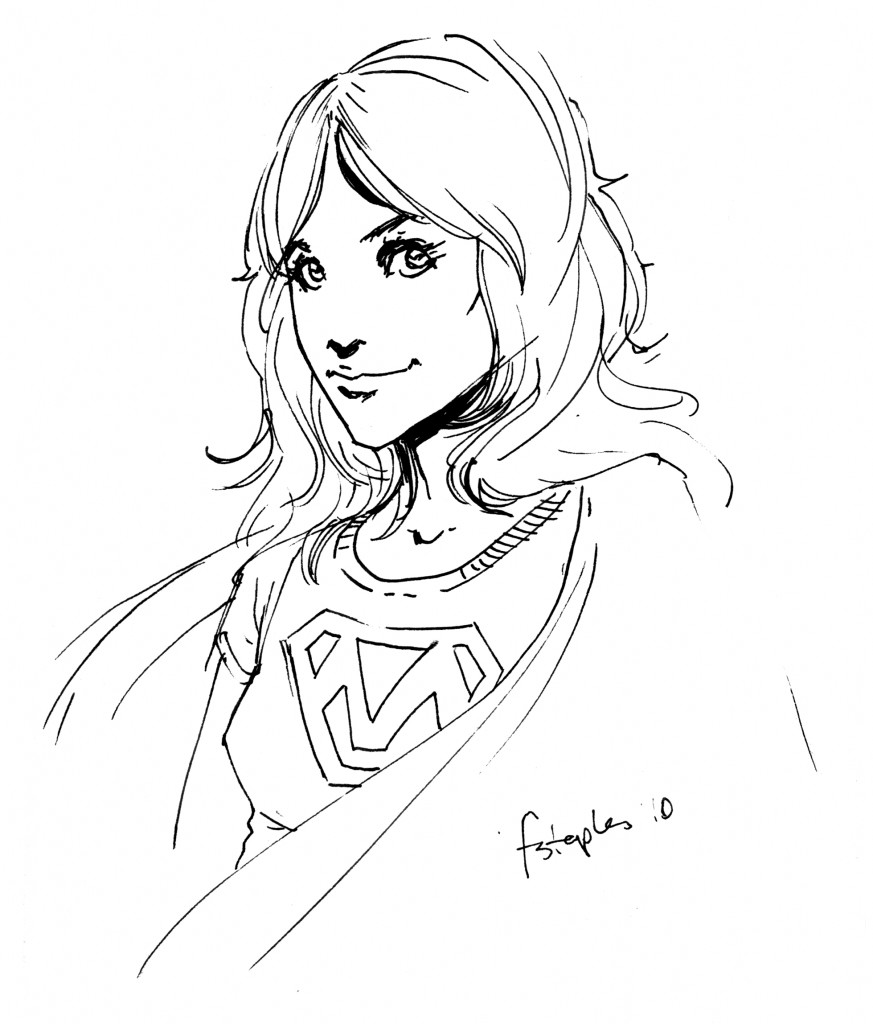
The supercool Carney’s House Party shirt made for me by HarperPerennial’s Jennifer Hart, aka @bookclubgirl. I would wear it every single day if I could get away with it.
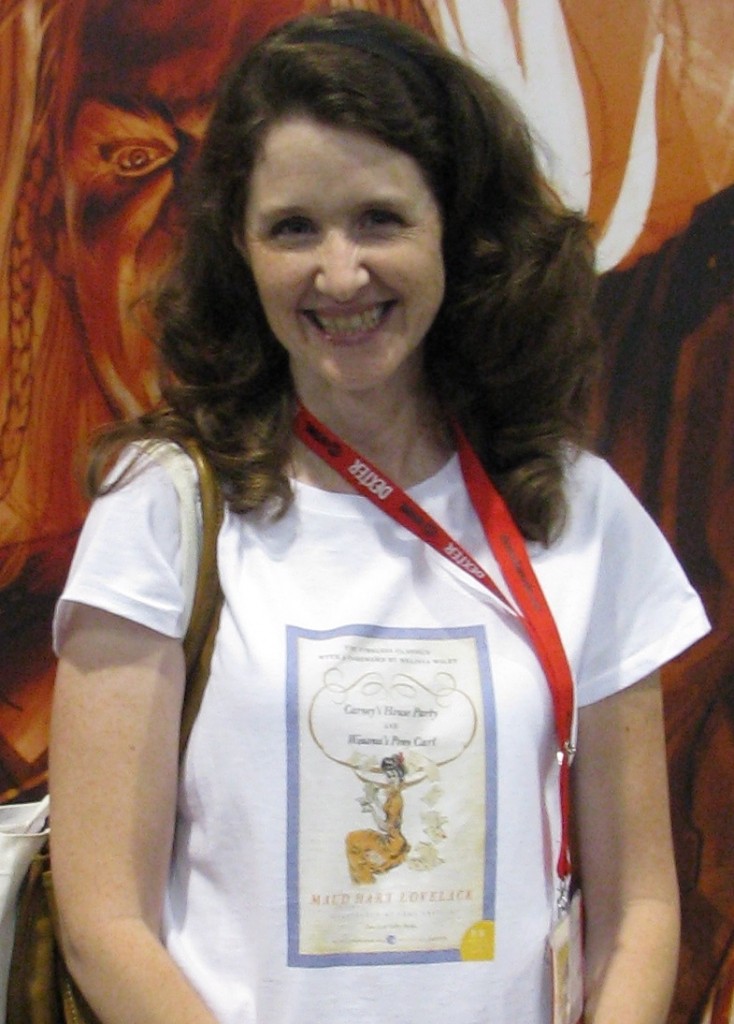





 Gene Luen Yang and Jennifer Holm at SDCC 2009.
Gene Luen Yang and Jennifer Holm at SDCC 2009.







